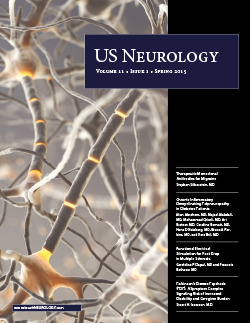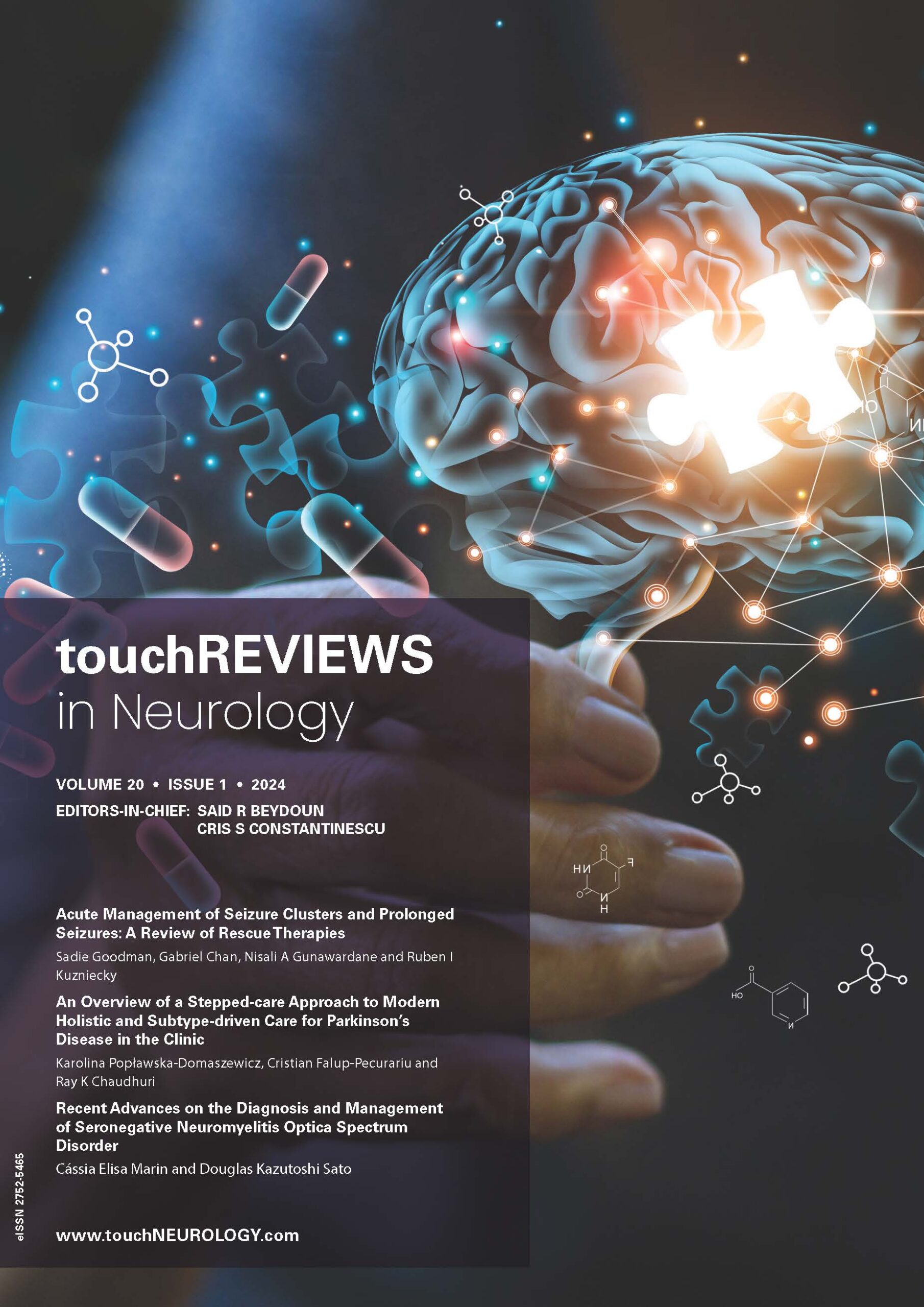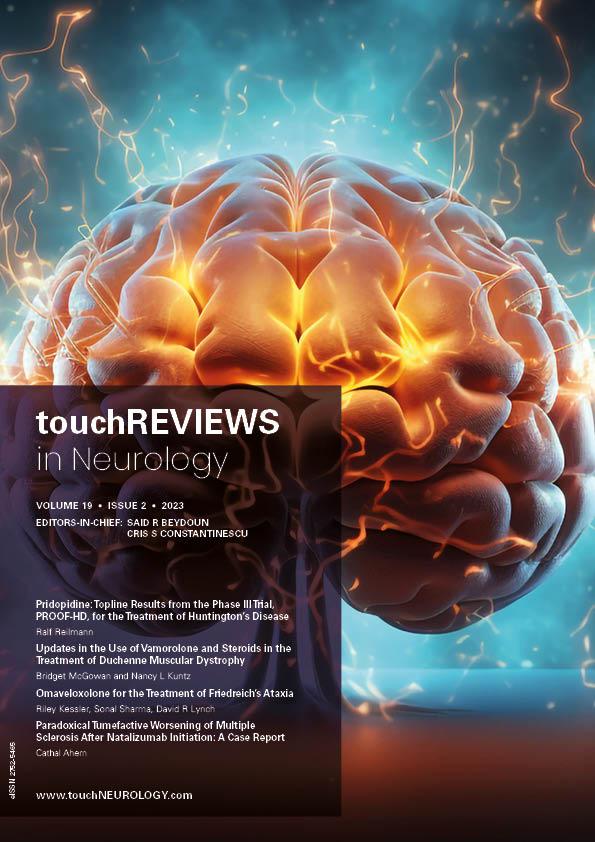US NEUROLOGY – VOLUME 11 ISSUE 1 – SPRING 2015
We are very pleased to present the spring edition of US Neurology. Editorial Board member Rosalind Kalb gives an excellent introduction to the edition and highlights the key articles. This edition features timely review articles and topical editorials, written by esteemed experts, succinctly examining a wide range of important topics including multiple sclerosis, stroke, headache, Parkinson’s disease and pain. Neuromuscular disorders are also extensively covered in this edition.
We hope you find this issue useful and that it provides helpful information and discussions that are relevant to your practice and interests. Please peruse and enjoy the expert content and we welcome any feedback you may have.
Welcome to the latest edition of US Neurology, which features a diverse range of articles covering several therapeutic areas. This edition begins with two articles on multiple sclerosis (MS): Bethoux and Dapul review the use of functional electrical stimulation for foot drop—highlighting its potential to complement other strategies to enhance mobility and safety in suitable […]
Multiple Sclerosis
Multiple sclerosis (MS) is a chronic, progressive disease of the central nervous system, believed to be caused by an autoimmune process, and resulting in demyelination and axonal loss in the brain, spinal cord, and optic nerves. MS affects approximately 400,000 individuals in the US alone and 2.5 million people worldwide. A decline in neurologic function, […]
Demyelinating disorders of the central nervous system (CNS) occur in approximately 1/100,000 children. About one-fifth of these children will eventually receive a diagnosis of multiple sclerosis (MS).1 These cases constitute approximately 2–5 % of all cases of MS.2 Of these children, up to three-quarters will experience cognitive decline, depression, and/or fatigue, and irreversible motor disability […]
Parkinson’s Disease
Parkinson’s disease (PD) is a progressive neurodegenerative synucleinopathy. Clinical diagnosis is based on the presence of motor symptoms, including bradykinesia, rigidity, rest tremor, and postural instability.1 Although the cause of PD is still unknown, the severe nigro-striatal dopamine loss provides the basis for dopaminergic treatment of motor symptoms. Nonmotor symptoms are also prominent, probably reflecting […]
Parkinson’s disease (PD) is the second most common neurodegenerative disorders worldwide1 and is a chronic and progressive condition,2,3 which affects 1 % of the older population (>60 years of age).4 Over the years, major research has been focused on the motor impairments in PD, which has contributed to the development of symptomatic treatments for these […]
Pain
Post-herpetic neuralgia (PHN), a neuropathic pain disorder resulting from nerve fiber damage following herpes zoster (HZ) infection, is caused by reactivation of the varicella zoster virus (VZV).1–3 VZV reactivation leads to the symptom complex commonly known as shingles.4 PHN is defined as VZV-associated pain persisting for more than 3 months after resolution of a VZV […]
Neuromuscular Disorders
Patient-reported Outcome Measures The primary aim of treating disease is to give patients freedom from symptoms, disability and side effects, and the freedom to function. Objectively and reliably measuring disability and quality of life (QoL) can be challenging but using patient-reported outcome measures (PROMs), in addition to clinical examination by physician, has proved a valuable […]
Chronic Inflammatory Demyelinating Polyneuropathy
Diabetes mellitus (DM) is a leading cause of peripheral neuropathy.1–3 A distal symmetric sensorimotor polyneuropathy (DSP), is the most common manifestation,4 and is considered to be mainly due to axonal degeneration and progressive loss of nerve fibers.5–7 However, focal and multifocal peripheral nerve lesions, comprising cranial, thoracoabdominal, and limb nerve lesions, including proximal lumbosacral radiculoplexus […]
Amyotrophic Lateral Sclerosis
Fasciculation, which is observed in various peripheral motor neuron disorders, is most frequently found in nonprogressive benign fasciculation syndrome (BFS).1 Patients with BFS never exhibit muscle atrophy or pathologic weakness and not all such patients visit hospitals; therefore, the prevalence and characteristics of BFS still need to be established. However, among the progressive disorders involving […]
Epilepsy
Seizures, paroxysmal neurological symptoms caused by episodic and pathologic neuronal discharging, have myriad associated signs/ symptoms that are dependent upon its anatomical origin and subsequent spread. The underlying causes of “epilepsy” (recurrent seizures) are many and include genetic factors, congenital and/or developmental anomalies, infections, trauma, and tumors. The incidence of epilepsy is approximately 1 %. […]
Stroke
The nation’s first Mobile Stroke Unit (MSU) was launched in February, 2014 by James Grotta, MD, and colleagues at the Texas Medical Center in Houston. The concept, pioneered by Marie Curie when she loaded an X-ray machine onto an ambulance during World War I, is logical: to take emergency care to the patient in order […]
Acute endovascular stroke therapy is designed to restore perfusion for patients with large vessel occlusions (LVOs) to hopefully minimize any eventual disability. This subgroup of severely affected stroke patients comprise only a minority of the 800,000 strokes that occur annually in the US.1 But this same group consumes a disproportionately large share of stroke care […]
Headache
Monoclonal antibody (mAb) treatment has revolutionized the approach to many diseases and represents a fast-growing area of drug development.1,2 They are composed of immunoglobulin G (IgG) isotypes, divided into four subclasses.3 In 1986, the US Food and Drug Administration (FDA) approved muromonab-CD3, the first mouse-derived therapeutic mAb indicated for transplant rejection.4 Human or “fully human” […]
The last major breakthrough in the treatment of migraine and cluster headache (CH) began in the 1980s with the development of subcutaneous sumatriptan, which was introduced to the US market in 1993. Sumatriptan was life-changing for many individuals with migraine, and began what was hailed as the “triptan revolution.” The “revolution” was followed by the […]

Trending Topic
The surge in social media use seems to have become a sign of our times. Social media has ramified into not only our personal lives but, importantly, also our professional lives and will continue to do so in the future.1–4 At the same time, more neurologists resorted to online learning modalities, including podcasts and social media […]
Journal Archive
touchREVIEWS in Neurology is a peer-reviewed, free-to-access, bi-annual neurology journal comprising review articles, case reports, practice guides, theoretical discussions, and original research. It features balanced and comprehensive articles written by leading authorities, addressing the most important and salient developments in the field of neurology.
Latest articles videos and clinical updates - straight to your inbox
Log into your Touch Account
Earn and track your CME credits on the go, save articles for later, and follow the latest congress coverage.
Register now for FREE Access
Register for free to hear about the latest expert-led education, peer-reviewed articles, conference highlights, and innovative CME activities.
Sign up with an Email
Or use a Social Account.
This Functionality is for
Members Only
Explore the latest in medical education and stay current in your field. Create a free account to track your learning.



















